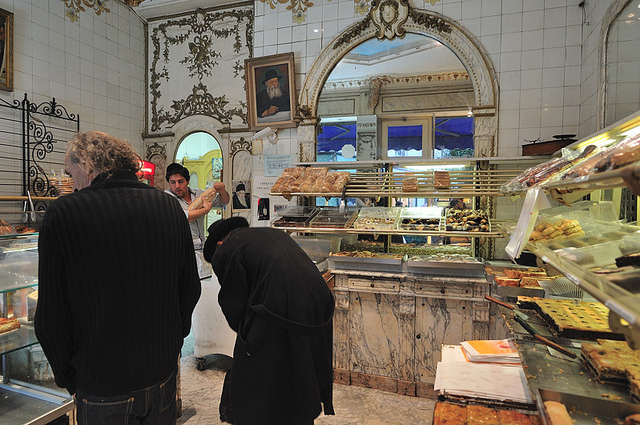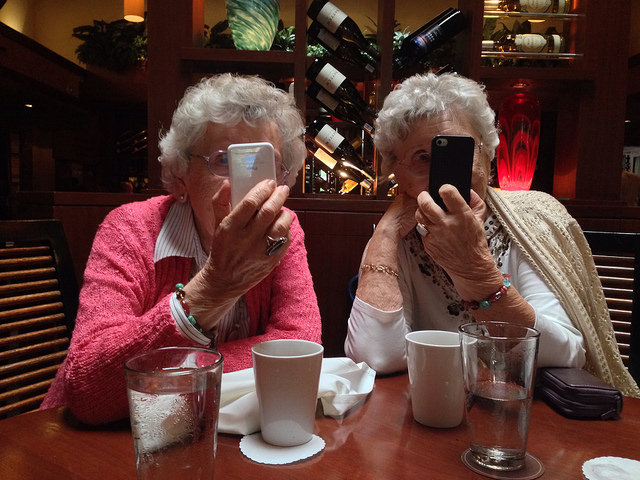Unlock the Magic in Your Story Now
Get the Free 20 questions to Ask Before Launching Your Idea workbook when you sign up for occasional updates.
Get the Free 20 questions to Ask Before Launching Your Idea workbook when you sign up for occasional updates.
Two Ways To Market
filed in Marketing, Storytelling, Strategy
 Which marketing is more effective?
Which marketing is more effective?
“Let me tell you about our best ever chocolate cake. All of the ingredients are sourced locally.
The butter is hand churned from the milk of Brown Swiss cows and the eggs were freshly laid this morning. We use fair trade organic cacao and the finest quality Belgian dark chocolate.
Our signature cake takes longer to make because of the triple sifting process we use, that creates a moist, melt-in-the-mouth sponge. It is finished with a rich chocolate ganache and hand shaved white chocolate and is guaranteed to change the way you think about chocolate cake forever.
You’ll love it!”
OR
“Tell me more about your birthday party guests…”
We can talk about our excellence and hope that people will listen, or we can simply be excellent and give them a story to tell. Our best marketing is in the listening and doing, not the telling.
Image by Guillermo Fdez.
Share this article
Questioning The Questions—The Truth About Your Data
 You’ve probably been on one of those calls to a service provider where having pressed, one, then two, then one again and being on hold for fifteen minutes you finally get to speak to a human being. Sadly, the undervalued team member at the call centre is charged with doing his best to troubleshoot his way off this call and on to the next in the minimum amount of time, while trying to avoid escalating your enquiry to a call out.
You’ve probably been on one of those calls to a service provider where having pressed, one, then two, then one again and being on hold for fifteen minutes you finally get to speak to a human being. Sadly, the undervalued team member at the call centre is charged with doing his best to troubleshoot his way off this call and on to the next in the minimum amount of time, while trying to avoid escalating your enquiry to a call out.
Eventually with the appointment time booked (without written confirmation as there is no template in his system that allows him to send an email or text) the operator asks if you can, ‘hang on the line to answer a two question survey to rate his service today, which was hopefully ten out of ten.’
And the questions are as follows:
A. Did we solve your problem today?
Yes or no.
B. On a scale of 1-10 how likely are you to recommend us to family and friends?
10 being the, ‘without a doubt because you are so awesome score.’
This kind of quantitative data gathering is flawed on so many levels. The framing of the questions is designed to get the answer you’re hoping for, and not necessarily the right answer or the most useful answer—the one that’s going to help your business to improve and make customers rave about your service.
12 Questions To Help You Gather More Useful Data
1. What are we really measuring here?
2. Are we willing to be more wrong than right?
3. Does what we are measuring actually help us to serve the customer better?
4. Who is this data trying to please?
5. Why does this matter to the customer?
6. What does the customer want us to obsess about?
7. How does what we measure change the posture of our team for better or worse?
8. Are we asking the right questions in the right way?
9. How to we know that we’re asking the most useful questions?
10. Are we trying to get at the truth so we can fix something or are we trying to confound it.
11. If we could only measure one thing what would that be?
12. Why aren’t we already measuring that?
The most useful questions we can ask are often the ones that prove us wrong rather than right.
Image by IMF.
Share this article
Your Best Offer Advantage
filed in Marketing, Storytelling, Strategy
 While working on my next book I was considering commissioning some independent research. Following a Skype conversation with a representative from a global research firm, where the investment seemed way outside my budget I received “some great news for in the form of a quote!”
While working on my next book I was considering commissioning some independent research. Following a Skype conversation with a representative from a global research firm, where the investment seemed way outside my budget I received “some great news for in the form of a quote!”
The consultant had spoken to a colleague and had called in a “personal favour”. I could now access an all caps, FREE trial license and gather up to the 800 responses needed for statistical significance. The cost to me— just $5,000 (significantly less than the verbal quote), the caveat being we needed to bill the project by the end of the month.
Nine days after the end of month deadline I got another email saying that he wasn’t sure we actually needed 800 responses after all, and that with just 385 completed surveys we could gather data with a 95% CI and .05 margin of error. This would cut the cost of the project in half.
I could be done and dusted for $2526.
By now it was very obvious how the sales consultant was motivated and rewarded. He must close the sale by any means possible, but not by bringing the highest value the company had to offer to the table until he had no choice. It must be hard to get up and bring yourself to work every day if your job is to convince people to pay the most possible for the least amount of effort.
Maybe this is what it takes to survive in the 21 billion dollar market research industry? But when you reach the point where you’ll do almost anything to close the deal then it shows.
There isn’t a single customer on the planet who wants to feel like they were closed, and another 7.3 billion and counting who want to be made to feel like they matter—that we did our best by them in every sense of the word.
Image by Daniel Weir.
Share this article
The Win Loss Mindset
filed in Marketing, Storytelling, Strategy
 Trade shows are interesting. You pay for the opportunity to set out your stall and market your wares to a generic, gender or interest demographic. It’s a game of hope and pitch, with a lot of waiting and rejection in between. For every person who buys something another ten walk past—unmoved and uncaring. Clearly not the right people.
Trade shows are interesting. You pay for the opportunity to set out your stall and market your wares to a generic, gender or interest demographic. It’s a game of hope and pitch, with a lot of waiting and rejection in between. For every person who buys something another ten walk past—unmoved and uncaring. Clearly not the right people.
And yet, as marketers we spend the majority of our time, energy and resources working out how to convince the ones who walked away, instead of putting all of our effort into obsessing over what resonated with the 1% who bought into the story.
It’s far easier to tell a story to people who want to listen.
Of course the Internet is a trade show on steroids.
The same rule applies wherever your story is told.
Image by Kevin Dooley.
Share this article
Where Big Ideas Begin
 Big ideas never start with a big idea—they start with a small problem, impacting a lot of people, that no one has worked out how (or cared enough) to solve.
Big ideas never start with a big idea—they start with a small problem, impacting a lot of people, that no one has worked out how (or cared enough) to solve.
Slack, Powerwall, Instacart, iTunes, GoPro, Simple and on and on, fall into this category.
You have to name the problem before you can begin to create the solution.
Image by Active Steve.
Share this article
The Characteristics Of Beloved Brands
filed in Marketing, Storytelling, Strategy
 Earlier this week Bob Lefsetz wrote the following line in a post about Elon Musk;
Earlier this week Bob Lefsetz wrote the following line in a post about Elon Musk;
“We know greatness when we see it, we clamor for it. We want to get closer to it.”
We also want to emulate it—to understand the qualities and characteristics that elevate certain leaders, businesses and brands above the rest. Analyse any brand that garners loyalty and love and you’ll find they all have these things in common.
The Characteristics Of Beloved Brands
Only five…
1. A muse.
Someone with a particular worldview, a desire, need or problem that they care about creating a difference for.
2. A visionary leader(s) who acts as a sherpa.
An individual (or a group), who knows what change they want to create in the world, and who stands up and says follow me.
3. A purpose.
A common vision.
4. A team with passion and skill who believe on executing on the vision.
People who will take the people they serve where they want to go.
5. A great product or service that marries the worldview, wants and needs of the muse with the company’s vision and purpose.
It turns out that great products are born from caring about the people they are for.
Image by Wendell.
Share this article
Marketing Is How It Feels
filed in Marketing, Storytelling, Strategy
 In a recent article I read that “….aside from a few television spots and billboards here and there, Apple pretty much ignores marketing and advertising.”
In a recent article I read that “….aside from a few television spots and billboards here and there, Apple pretty much ignores marketing and advertising.”
This is simply not true. EVERYTHING Apple does, from the massive investment in package design that creates scissorless, video-worthy unboxing experiences, to product names, Genius training, years spent obsessing over every detail of a new product, glass staircases and Macbook screens angled so that you must touch them in order to interact with the product in store, is marketing.
Apple’s $1.2 billion spend on advertising (just 0.7% or their revenue) pales into insignificance when you consider the resources the company dedicates to creating meaningful products and experiences.
Marketing is neither medium or message, it’s how it feels to get close to your brand—which means everything that the customer sees, hears, tastes, smells and experiences (not just your advertising budget) is your marketing.
It really is time to stop confusing the two and to remember that now more than ever before, great advertising can’t and won’t rescue a mediocre product or experience.
Your brand story is not just something you say. It’s all that you do.
Image by Rob Boudon.
Share this article
Awareness Is Overrated
 Every entrance and exit to the market was in lock down on Saturday. The footpaths, walkways and zebra crossings we each covered by teams of two volunteers shaking collection tins and asking for donations. Several over-enthusiastic volunteers stepped out into the path of oncoming pedestrians to make saying ‘no’ was a physical act. Back home later that day a knock on the door and another ask confirmed that this was definitely a planned weekend blitz.
Every entrance and exit to the market was in lock down on Saturday. The footpaths, walkways and zebra crossings we each covered by teams of two volunteers shaking collection tins and asking for donations. Several over-enthusiastic volunteers stepped out into the path of oncoming pedestrians to make saying ‘no’ was a physical act. Back home later that day a knock on the door and another ask confirmed that this was definitely a planned weekend blitz.
The tactics were designed to create awareness and encourage people to give a one-off donation, and maybe the coffers are a little fuller this Monday morning, but by inviting people to pay volunteers to go away the charity loses.
What if they did the opposite? What if every tactic they used created a stronger bond with the donor and bit by bit people were invited to pay with time, money or effort, to belong?
It turns out that getting people to notice us is rarely the biggest problem we face.
Image by ATB910.
 It’s easy to erect a billboard that broadcasts to everyone—far harder to build a bridge to meaningful engagement with the people who matter.
It’s easy to erect a billboard that broadcasts to everyone—far harder to build a bridge to meaningful engagement with the people who matter.  Consistent marketing…
Consistent marketing…